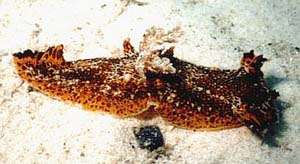Nudi burying itself
February 2, 1998
From: Bill Chambers

Concerning the web-page, I wish you well, and hope that it will be a resounding success! Thanks for the effort!
Attached is a TIF file of another Nudi taken at Little Beach, Nelson Bay, Port Stephens, NSW on 01FEB98. The depth was 5m over a sandy bottom. The unusual thing (for me) about this Nudi is that it was in the process of burying itself under the substrate when first observed. It was actually flicked out of the sand with a finger prior to it's recovery and the resulting photo. I have another shot of it partially buried & bent double.
Once again thanks for your time!
Warm Regards,
Bill Chambers.
This is Plocamopherus tilesii. Species of Plocamopherus have a number of interesting features. They have paired 'appendages' down each side of the body some of which end in a large rounded knob. At least in Plocamopherus imperialis and P. ceylonicus these knobs can flash a bright luminescent light when disturbed. These animals can also turn the back end of the body into a high flattened paddle which is useful in helping the slug swim through the water with vigorous side to side movement of the body. They feed on bryozoans. Your observation on them burrowing is very interesting and I have no recollection of it being reported before. It is interesting that this species has a very wide foot which is found in other burrowing slugs such as the aeolid Cerberilla. Any other reports of burrowing or unusual behaviour would be very welcome... Bill Rudman
Rudman, W.B., 1998 (Feb 2). Comment on Nudi burying itself by Bill Chambers. [Message in] Sea Slug Forum. Australian Museum, Sydney. Available from http://www.seaslugforum.net/find/119Related messages
-
Plocamopherus tilesii from Queensland
From: Nigel Holmes, November 12, 2002 -
Plocamopherus tilesi or tilesii
From: Wayne Ellis, July 5, 1999 -
Plocamopherus tilesii from Port Stephens, NSW
From: Grey McNeil, June 29, 1999
